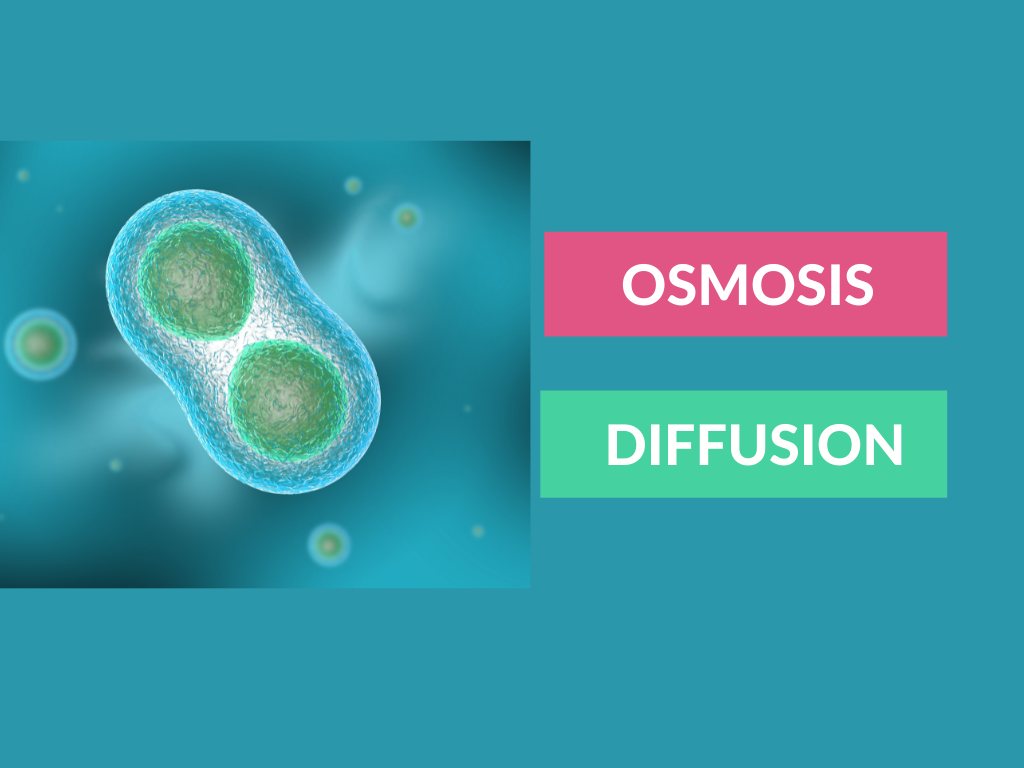For moving molecules in and out of the cell, two types of transport systems are present. They are osmosis and diffusion. These two transport systems follow passive transport as they don’t require any energy to function.
What is Osmosis?
Osmosis is the spontaneous process of movement of solvent molecules from a dilute solution (more water molecules) to a concentrated solution (less water molecules) across a semipermeable membrane. Osmosis is a passive transport process and does not require any energy to complete the process.
For example, movement of water from soil to plants through the roots.
For example, swelling of RBC when exposed to freshwater. The freshwater will enter into RBC through the cell membrane and the swelling will occur.
What is Diffusion?
Diffusion is the movement of molecules or particles from higher concentration to lower concentration until equilibrium is achieved. Simple diffusion is also a passive transport process that does not require any energy but facilitated diffusion requires ATP. Diffusion does not require any semipermeable membrane for the movement of particles.
For example, After spraying perfume, the aroma will diffuse in the air from high concentrated areas to low concentrated areas.
For example, When a tea bag is dipped in hot water, the tea flavor will move from a high concentrated area (tea bag) to a low concentrated area (hot water).
Differences Between Osmosis and Diffusion
| Osmosis | Diffusion |
|---|---|
| Definition | |
| Osmosis is a spontaneous process of movement of solvent molecules from dilute solution to concentrated solution across a semipermeable membrane. | Diffusion is a spontaneous process of movement of particles from a high concentration to a low concentration until equilibrium is achieved. |
| Medium | |
| Osmosis occurs in only a liquid medium. | Diffusion occurs in solids, liquids, and gases. |
| Importance | |
| In animals, osmosis helps in the distribution of nutrients and the release of metabolic waste products. In plants, osmosis helps in the absorption of water from the soil to roots. | Diffusion helps in the exchange of gases by respiration, photosynthesis, transpiration, and creating energy. |
| Concentration gradient | |
| In osmosis, the movement of particles occurs from a high concentrated area to a low concentrated area. | In diffusion, the movement of particles occurs from a high concentrated area to a low concentrated area. |
| Solute potential | |
| Osmosis depends on solute potential. | Diffusion does not depend on solute or water potential. |
| Equilibrium | |
| The concentration of solvent does not equal on both sides of the membrane. | The concentration of diffusing substances or particles equalizes to fill the available spaces. |
| Solution type | |
| Osmosis occurs between similar types of solutions. | Diffusion occurs between dissimilar and similar types of solutions. |
| Stopping or reversing of Transport | |
| Osmosis can be reversed or stopped by applying additional pressure. | The diffusion process can neither be reversed nor stopped. |
| Flow of particles | |
| The flow of particles occurs on one side. | The flow of particles occurs in all directions. |
| Water requirement | |
| Osmosis requires water for the movement of particles. | Diffusion doesn't require water for the movement of particles. |
| Semi permeable membrane | |
| Osmosis requires a semi-permeable membrane | Diffusion doesn't require a semi-permeable membrane. |
| Examples | |
| Water from soil to roots in plants | Spraying of perfume. |
Conclusion
Both osmosis and diffusion are passive transport systems that cause the movement of particles from a higher concentration to a lower concentration area with or without the presence of a semi-permeable membrane. Osmosis can only function in a liquid medium and in presence of a semipermeable membrane whereas diffusion can occur in all three mediums (liquids, gases, and solids) and does not require any semipermeable membrane. These two transport systems play an important role in biological systems.


